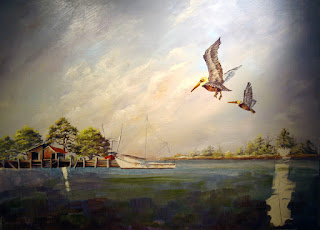Learning to paint is a first step, but learning to be "painterly" in style is just as desirable. Beginners almost always work for the control over a brush, but as we learn and grow, we desire to relax and become more painterly... less labored in style and effect. When we begin to relax and paint for the sake of art, we are truly blessed with a new experience.
The area half way between the viewer and the horizon my subject plane. This means it will have the most detail, contrast and colour. I delight in painting this area, but it can also be very intimidating at first. If the mind does not have enough information before the brush goes into action, disaster is certain.
To avoid this mistake, I set the canvas on the easel and begin to think about what I will do next. I refer to my notes, sketches and photos for information. I make key decisions about what should be left out and what should be simplified or altered. After all, I am the artist and this needs to be a work of artistic interpretation... not a copy of a photograph.
Control your attack on the painting. Decided carefully what should be worked on next. Plan a program of addressing one item at a time.
I was anxious to paint the pelicans. The sky was dry and I had gone back in with a soft pencil and drawn the birds back in using my original sketches.
Birds look so different in different seasons, at different ages and of course there are many varieties. Be sure you use the variety that is natural to your painting location. If you are not familiar with birds and how to paint them, visit the works of other artists on the web, at the museums or a trip to the library. The confidence and information you gain will be worth the trip.
I mixed lots of Liquin (my preferred medium) with Brown Madder for the beaks and bellies, yellow Ocre for the heads, and a mixture of greys for the wings and backs. The paint was so thin that it was transparent making for great textures. I will consider this an "under-paintng" and let it dry before going back to add more detail. Don't forget the eyes of the brown pelican can be Cerulean blue!
The Fish houses and docks need to look weathered. New boats and docks never make for good paintings except for loft apartments for NYC. 'Nuf said.
My contrast is to be strong here. Unlike the back bank, the darks are nice and dark and the light details are crisp and warm. Let the 2 hair brush go wild, but be sure it is fun and relaxed or it will look as painful as it was to paint.
The main shrimper will be my next focus. I worked on it a bit and the paint is like butter so I will let it dry a bit before doing more. I want my details to be clean and crisp. I will carefully study my photos to get all the rigging right.
If you paint trawlers in the New England area, be aware the rigging
will be different as it is for all areas.
I hope your mind can paint along with my sharing. It is important to imagine doing each step yourself before you ever pick up the brush. If you can see it in your mind's eye and feel the emotion and excitment of capturing a special effect, you are half way there!!
A painting is above all a product
of the artist's imagination;
it must never be a copy.
...Edgar Degas
Thank you for visiting my blog.
I hope you will join in order to receive a notice when I post my next session for this painting.



No comments:
Post a Comment